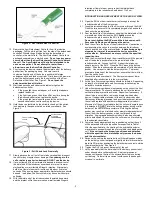
MicroVention, Inc.
2
PD110323 Rev. A
Figure 1 – Diagram of Azur System Setup
PREPARATION OF THE AZUR SYSTEM FOR DELIVERY
Figure 2 – Azur Detachment Controller
Indicator Light
Azur delivery
pusher
Detachment Button
Funnel
Insertion Direction
12.
Remove the Azur Detachment Controller from its protective packaging. Pull the
white pull-tab from the side of the detachment controller. Discard the pull-tab
and place the detachment controller in the sterile field. The Azur Detachment
Controller is packaged separately as a sterile device.
Do not use any power
source other than the Azur Detachment Controller to detach the coil. The
Azur Detachment Controller is intended to be used on one patient. Do not
attempt to re-sterilize or otherwise re-use the Azur Detachment Controller.
13. Prior to using the device, remove the proximal end of the delivery pusher
from the packaging hoop. Use care to avoid contaminating this end of the
delivery pusher with foreign substances such as blood or contrast. Firmly insert
the proximal end of the delivery pusher into the funnel section of the Azur
Detachment Controller. See Figure 2.
Do not push the detachment button at
this time.
14. Wait three seconds and observe the indicator light on the detachment controller.
• If the green light does not appear or if a red light appears, replace the device.
• If the light turns green, then turns off at any time during the three-second
observation, replace the device.
• If the green light remains solid green for the entire three-second observation,
continue using the device.
15. Hold the device just distal to the shrink-lock and pull the shrink-lock proximally
to expose the tab on introducer sheath. See Figure 3.
Figure 3 – Pull Shrink Lock Proximally
Tab on introducer sheath
Pull shrink-lock proximally
16.
Slowly advance the coil out of the introducer sheath and inspect the coil for
any irregularities or damage.
If any damage to the coil or delivery pusher is
observed, DO NOT use the device.
17. With the distal end of the introducer sheath pointed downward, gently retract the
implant back completely into the introducer sheath about 1 to 2 cm.
INTRODUCTION AND DEPLOYMENT OF THE AZUR SYSTEM
18. Open the RHV on the microcatheter just enough to accept the introducer sheath
of the Azur system.
19.
Insert the introducer sheath of the Azur system through the RHV. Flush the
introducer until it is completely purged of air and saline flush exits the proximal
end.
20.
Seat the distal tip of the introducer sheath at the distal end of the microcatheter
hub and close the RHV
lightly
around the introducer sheath to secure the RHV
to the introducer.
Do not over-tighten the RHV around the introducer sheath.
Excessive tightening could damage the device.
Azur delivery pusher proximal end
connects to detachment controller
One-way stopcock
Line to flush solution
3-way stopcock
Line to flush solution
Guide catheter
Blood vessel
Femoral sheath
Microcatheter Distal Tip RO marker band
Coil Implant
Microcatheter
RHV
Line to flush solution
3-way stopcock
RHV
















